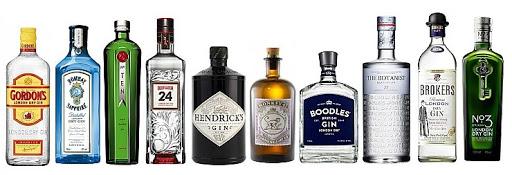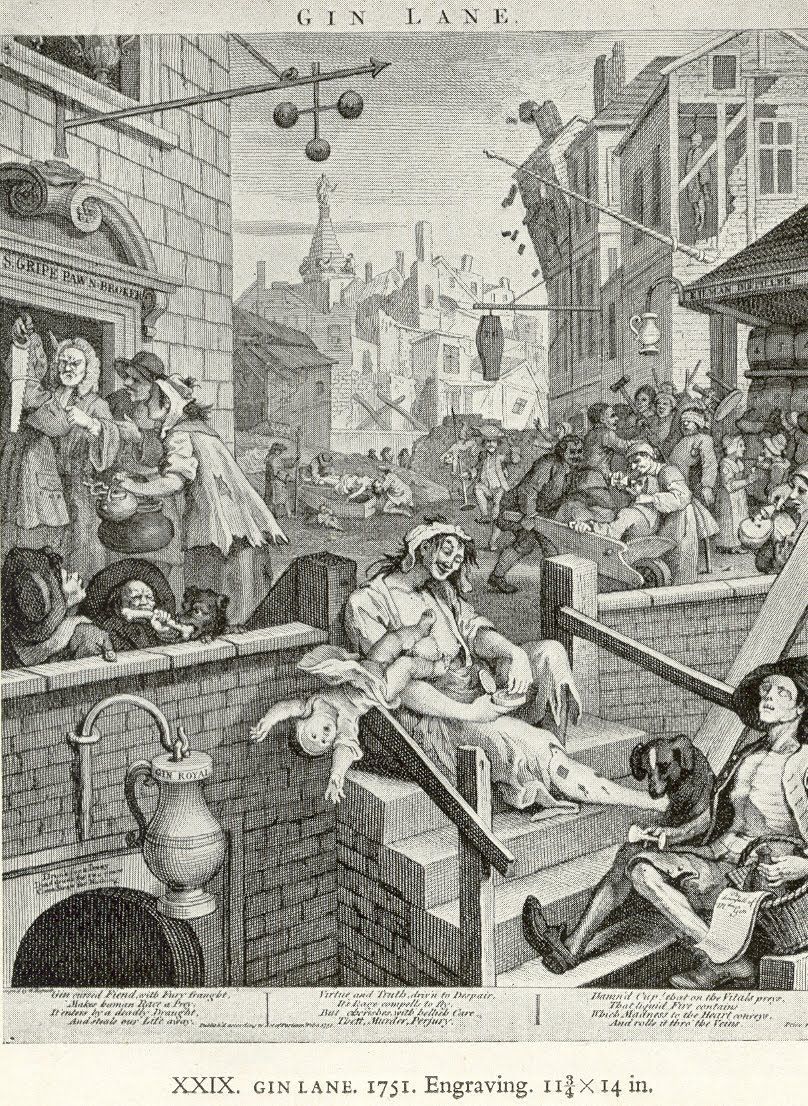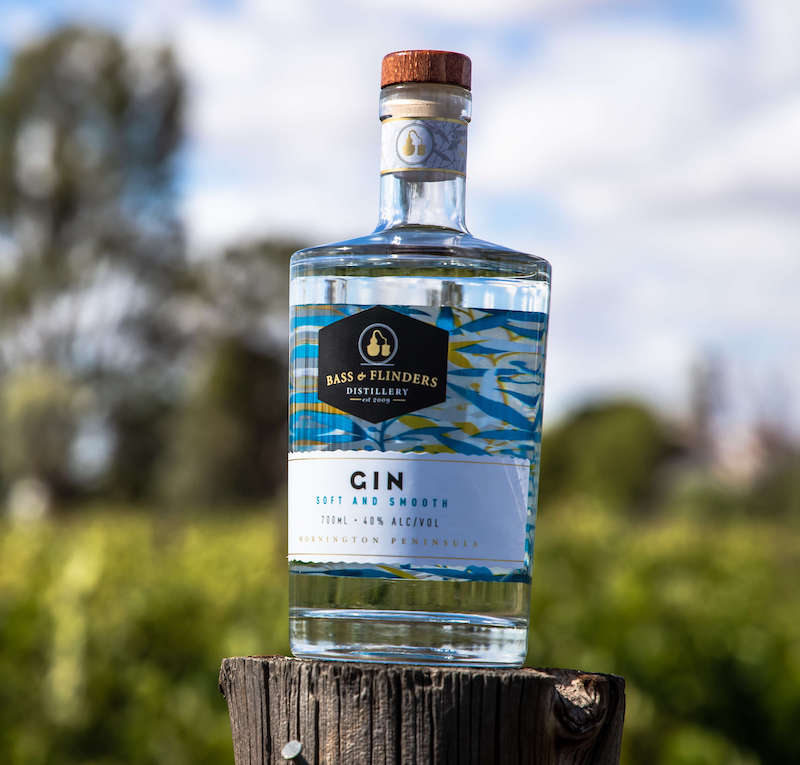
진은 세계 6대 기주라고 불리는 술중 하나로 깔끔하면서 다양한 향을 가진 술임
진의 역사든 다른 증류주(럼, 데킬라, 보드카 등)과는 다르게 어느정도 기원이 확실함
1649년 네덜란드의 의학 박사 프란시스퀴스 실비우스 드 부베(Franciscus Sylvius de la Boe)라는 사람이 당시 열병에 효과가 있다고 알려진 주니퍼베리 열매를 증류해 약용주로 만들어 주네버(genever) 라는 이름으로 판매를 시작했다 함
이후 17세기부터 주네버가 영국으로 수출되기 시작하는데 여기에서 명예혁명이 큰 캐리를 해버림
명예혁명 이후 네덜란드 출신인 윌리엄 3세가 집권하며
프랑스산 브랜디등 수입주의 수입세를 올리고 주니퍼베리의 생산량을 늘리는 정책을 시행함.
이 과정에서 주네버라는 술이 만들기도 간단한데 재료도 늘어나니까 큰 인기를 얻게됨 이후 이름이 점점 영국식으로 변하면서 주네버라는 이름이 짤려서 'gen'이 되고 이게 영국식으로 한번 더 변하면서 gin이라는 현재 명칭으로 고정됨
이후 17세기중 원래 국민 술에 가까웠던 럼이 나폴레옹의 침략전쟁, 미국의 독립운동으로 아이티, 인도지역이 뺏기면서 럼의 재료인 당밀을 수입하기 힘들어지자
럼을 대체하기 위해 진을 선택했으나 진의 주니퍼베리 향이 익숙하지 않기도 하고 알코올 향을 줄이면서 주니퍼베리의 향을 살리려면 생산 단가가 올라가기에 영국인들은 주니퍼베리향을 빼고 드라이한 향을 가진 진을 만들어냄 여기서 현재 가장 많이 사용되는 진인 런던 드라이 진의 기원이 됨
어쨋든 주니퍼베리 향을 줄이면서 진의 생산단가가 내려가자 싸구려 진이 우후죽순으로 출시됨. 이 시점부터 영국에서 진을 소비하는 사람이 너무 늘어나자 알코올 중독이 사회의 문제로 떠오르기 시작함

그때의 참상을 나타낸 그림 '진 거리'
사람들이 진을 마시기 위해 별 지랄을 다 하니까
영국 정부는 '진 법'을 제정해 술의 제작을 줄여보려고 했는데 결국은 암시장에서 유통되면서 공급은 그대로였음. 결국 영국 정부는 진 법을 개정해 진의 판매를 줄이게 됨.
이후 가격이 싸다는 장점을 살려 서양 칵테일의 기주로 다양하게 활용되게 되었음
여담이지만 진 하면 생각나는 대표적인 칵테일중 하나인 진 토닉은 의외로 인도지역에서 시작했다 함
영국군이 인도를 점령했을 당시 영국군이 말라리아를 예방하기 위해 퀴닌 섭치를 원활하게 할 방법을 찾다가
물, 설탕, 라임을 넣었고 이거에 진을 넣어 마신걸 계기로 한 상인이 탄산을 포함한 토닉 워터를 만들어 1856년 최초의 진 토닉이 탄생했다 함
https://www.bassandflindersdistillery.com/blogs/news/history-of-gin
 History of Gin Where did it all be-GIN? Gin lovers…have you ever stopped to think about the origins of gin and where the humble spirit was first created? At Bass and Flinders, our passion for adventure and our thirst for knowledge (pardon the pun) about perfectly crafted gins, led us to wonder just how this all started. Gin has a long and rich history and has a fascinating tale to tell. To truly understand the history of gin, let’s go back to the beginning. What Makes Gin, Gin? Gin as we know it today, is a distilled alcohol that by definition must include the characteristic aroma and flavour of the juniper berry. Even the name itself is derived from the Dutch word for juniper ‘genever’, or the French ‘genièvre’. The quality of the berry and the way the gin is crafted, all play a part in determining the character of fine gins. Where Did Gin Actually Originate? There are many stories about the origins of gin and how it was created. It is rumoured that the origins of this classic beverage can be traced back as far as the 11th century where it was used as medicine. The Benedictine monks of Salerno, Italy distilled spirits using juniper berries (growing in abundance in the nearby hills) as a cure for a wide range of ailments including indigestion, and for treating conditions of the stomach, kidneys and liver. Juniper Tonic Gin as we know it today, is based on an old Dutch liquor called ‘jenever’, a blend of grain-based malt wine and a neutral spirit infused with Juniper, which was used to mask its harsh flavour. In the 1340’s the Bubonic Plague, or “Black Death” had spread to Europe from Central or East Asia and it is believed, that people across Europe consumed a form of this juniper tonic in the vain hope of warding off the deadly disease. By the middle of the century production levels of jenever in The Netherlands (and Amsterdam in particular) was huge. Dutch Courage Fast-forward to the 17th century, during the struggles for The Netherland’s independence from Spain, when English soldiers were sent to war to assist the Dutch revolt against their Spanish Catholic rulers. They say that this is where the British got their first taste of gin. While the English soldiers were fighting alongside their Dutch allies, they would have seen the troops drinking jenever before going into battle, to relax and bolster themselves with a generous nip of something they called “Dutch courage.” Gin Migrates To England The soldiers returned home with a taste for this new spirit and introduced gin to England, but it wasn’t until the late 1600’s when gin really started to take off in London. William of Orange took the throne and became King of England in 1689. In an attempt to bolster the British economy, he introduced heavy taxes on imported spirits such as French wine and Cognac and instituted the ‘Corn Laws’, a tax break on domestic spirit production and trade restrictions on imported food and grain. The Gin Craze This catapulted the country into a period known as the Gin Craze. Thousands of gin shops were springing up all over London, anyone could produce it. A pint of gin became cheaper than beer. For many poor Londoners, gin became a cheap buzz that could be had for pennies, an escape from cold and hunger with every serve. Some workers were even paid with gin as part of their wages! With very little regulation, producers started using poor quality grain and added other bulking agents like turpentine and sulphuric acid to the mix. The result was devastating. The phrase ‘Mothers Ruin’ was coined, as the raw spirit became the source of misery across London – rising crime, prostitution, blindness and death. London was swarming with people who were drunk or driven mad by the spirit. Gin Goes Underground After some time, Parliament recognised they had an enormous problem on their hands and tried to slow down the city’s thirst for gin by passing new laws. George II was on the throne and the 1736 Gin Act was passed. Anyone making gin now needed a license, extortionate fees were introduced and gin shops were heavily taxed, but this only sent production underground. Only two licenses were officially taken out and production was increasing. Bootleggers were everywhere, making it in their own homes - giving birth to the phrase ‘bathtub gin.’ The Beginning of Artisanal Gin Then came the Gin Act of 1751. It changed the way gin was sold. License fees were lowered and distillers had to sell to licensed retailers. At the same time, as the result of a poor harvest, grain prices also increased and better quality spirit was produced. Parliament introduced a minimum output requirement and doubled the duties on distilled spirits, putting the price of gin out of the reach of the lower classes and consumption started to fall. By 1757 the Gin Craze was over. Gin distilleries started producing high quality gin and England became a nation of beer drinkers once again. A New Still Design Some decades later, things started looking up for London gin with the invention of a new continuous still by Aeneas Coffey in 1832. At the time, distillers all used a traditional alembic pot still, significantly limiting the amount of production. With the invention and development of the new column still, the distillation of spirits became a more practical opportunity. Coffey’s still was efficient, easy to maintain and used less fuel. It saved distilleries a fortune and increased production levels. How The G&T Came To Be… It was then the global deployment of the British Navy that enabled gin to become famous worldwide. While in India, the Royal Navy started to combine gin with an anti-malarial medication. Their pure quinine rations tasted so awful they added gin to the mix, and a touch of lime to ward off scurvy. Quinine is the base ingredient of tonic water and so the G&T was born! The Rise of Artisanal Handcrafted Spirits The delicate and exotic botanicals our master distillers use in gins today are a world away from the harsh spirit of times gone by. It has transformed from a mediaeval herbal tonic to a modern, handcrafted spirit in high demand across the globe. Cocktail culture is back and the world is in love with artisanal craft made spirits – gin is cool again! from BASS & FLINDERS DISTILLERY
History of Gin Where did it all be-GIN? Gin lovers…have you ever stopped to think about the origins of gin and where the humble spirit was first created? At Bass and Flinders, our passion for adventure and our thirst for knowledge (pardon the pun) about perfectly crafted gins, led us to wonder just how this all started. Gin has a long and rich history and has a fascinating tale to tell. To truly understand the history of gin, let’s go back to the beginning. What Makes Gin, Gin? Gin as we know it today, is a distilled alcohol that by definition must include the characteristic aroma and flavour of the juniper berry. Even the name itself is derived from the Dutch word for juniper ‘genever’, or the French ‘genièvre’. The quality of the berry and the way the gin is crafted, all play a part in determining the character of fine gins. Where Did Gin Actually Originate? There are many stories about the origins of gin and how it was created. It is rumoured that the origins of this classic beverage can be traced back as far as the 11th century where it was used as medicine. The Benedictine monks of Salerno, Italy distilled spirits using juniper berries (growing in abundance in the nearby hills) as a cure for a wide range of ailments including indigestion, and for treating conditions of the stomach, kidneys and liver. Juniper Tonic Gin as we know it today, is based on an old Dutch liquor called ‘jenever’, a blend of grain-based malt wine and a neutral spirit infused with Juniper, which was used to mask its harsh flavour. In the 1340’s the Bubonic Plague, or “Black Death” had spread to Europe from Central or East Asia and it is believed, that people across Europe consumed a form of this juniper tonic in the vain hope of warding off the deadly disease. By the middle of the century production levels of jenever in The Netherlands (and Amsterdam in particular) was huge. Dutch Courage Fast-forward to the 17th century, during the struggles for The Netherland’s independence from Spain, when English soldiers were sent to war to assist the Dutch revolt against their Spanish Catholic rulers. They say that this is where the British got their first taste of gin. While the English soldiers were fighting alongside their Dutch allies, they would have seen the troops drinking jenever before going into battle, to relax and bolster themselves with a generous nip of something they called “Dutch courage.” Gin Migrates To England The soldiers returned home with a taste for this new spirit and introduced gin to England, but it wasn’t until the late 1600’s when gin really started to take off in London. William of Orange took the throne and became King of England in 1689. In an attempt to bolster the British economy, he introduced heavy taxes on imported spirits such as French wine and Cognac and instituted the ‘Corn Laws’, a tax break on domestic spirit production and trade restrictions on imported food and grain. The Gin Craze This catapulted the country into a period known as the Gin Craze. Thousands of gin shops were springing up all over London, anyone could produce it. A pint of gin became cheaper than beer. For many poor Londoners, gin became a cheap buzz that could be had for pennies, an escape from cold and hunger with every serve. Some workers were even paid with gin as part of their wages! With very little regulation, producers started using poor quality grain and added other bulking agents like turpentine and sulphuric acid to the mix. The result was devastating. The phrase ‘Mothers Ruin’ was coined, as the raw spirit became the source of misery across London – rising crime, prostitution, blindness and death. London was swarming with people who were drunk or driven mad by the spirit. Gin Goes Underground After some time, Parliament recognised they had an enormous problem on their hands and tried to slow down the city’s thirst for gin by passing new laws. George II was on the throne and the 1736 Gin Act was passed. Anyone making gin now needed a license, extortionate fees were introduced and gin shops were heavily taxed, but this only sent production underground. Only two licenses were officially taken out and production was increasing. Bootleggers were everywhere, making it in their own homes - giving birth to the phrase ‘bathtub gin.’ The Beginning of Artisanal Gin Then came the Gin Act of 1751. It changed the way gin was sold. License fees were lowered and distillers had to sell to licensed retailers. At the same time, as the result of a poor harvest, grain prices also increased and better quality spirit was produced. Parliament introduced a minimum output requirement and doubled the duties on distilled spirits, putting the price of gin out of the reach of the lower classes and consumption started to fall. By 1757 the Gin Craze was over. Gin distilleries started producing high quality gin and England became a nation of beer drinkers once again. A New Still Design Some decades later, things started looking up for London gin with the invention of a new continuous still by Aeneas Coffey in 1832. At the time, distillers all used a traditional alembic pot still, significantly limiting the amount of production. With the invention and development of the new column still, the distillation of spirits became a more practical opportunity. Coffey’s still was efficient, easy to maintain and used less fuel. It saved distilleries a fortune and increased production levels. How The G&T Came To Be… It was then the global deployment of the British Navy that enabled gin to become famous worldwide. While in India, the Royal Navy started to combine gin with an anti-malarial medication. Their pure quinine rations tasted so awful they added gin to the mix, and a touch of lime to ward off scurvy. Quinine is the base ingredient of tonic water and so the G&T was born! The Rise of Artisanal Handcrafted Spirits The delicate and exotic botanicals our master distillers use in gins today are a world away from the harsh spirit of times gone by. It has transformed from a mediaeval herbal tonic to a modern, handcrafted spirit in high demand across the globe. Cocktail culture is back and the world is in love with artisanal craft made spirits – gin is cool again! from BASS & FLINDERS DISTILLERY


